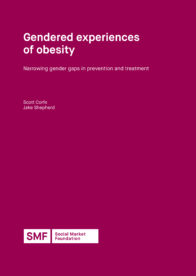This report explores gendered experiences of obesity in the UK , examining how obesity rates differ between men and women, the drivers of these trends and the extent to which policy aimed at reducing obesity rates needs to be gender specific.
The key findings of our research are outlined below.
Trends in obesity rates among men and women
- In England, the obesity rate is slightly higher for women (29%) than for men (27%). However, men are significantly more likely to have overweight (41% vs 31% for women).
- Across both genders, obesity rates in England have increased by a similar amount since the early 1990s. Between 1993 and 2019, the obesity rate among women rose from 16% to 29%, while for men it increased from 13% to 27%.
- In England, obesity rates are higher for women than for men among those aged 25-54, while among those aged 55-74, men have higher obesity rates. Among the youngest age group in the data, 16-24, men have a higher obesity rate, while among the oldest age group (75+) women have a higher obesity rate.
- Women have significantly higher obesity rates than men in the North East of England, Yorkshire & the Humber, the East Midlands and London.
- A driver of higher rates of female obesity, relative to men, in regions such as the North East and Yorkshire & the Humber, is likely to be relatively low household incomes. Among those living in the least deprived 20% areas of England, obesity rates among men and women are the same (22%), However, among the most deprived 20% of areas, the obesity rate for women stands at 39%, while for men the rate is significantly lower at 30%. That is to say, poverty appears to have a much more significant impact on obesity rates among women.
Drivers of obesity by gender
- In the UK, it has been estimated that increased energy intake (calorie consumption) accounted for the entirety of the increase in body weight in women between 1986 and 2000, but not in men. For men, the increase in body weight over this period is likely to be due to a combination of increased total energy intake and reduced physical activity levels.
- Women are more likely to have medical conditions that contribute to weight gain and difficulty losing weight. For example, thyroid disease is much more common in females than in males, with reported prevalence ranging from two to eight times higher in women.
Gendered experiences of obesity treatment
- Women are more likely to be invested in diet than men. However, males with excess weight are more likely to exercise than females.
- Men are much less likely to undergo bariatric surgery to lose weight and men with obesity are less likely to be using weight loss medication. In 2015, a study conducted in Northern Ireland estimated that 0.6% of men with obesity were on anti-obesity medication, compared with 2.1% of women with obesity.
- Women are much more likely to be referred to weight loss programmes by GPs. Despite being just as likely to accept, men make up only 1 in 10 referrals.
- SMF-commissioned survey data shows that women are more comfortable speaking to others about their weight than men.
Policy recommendations
- Both the NHS and commercial service providers should look to review their existing weight management programmes, with a view to incorporating male-friendly components into future designs.
- Local authority-managed gyms, swimming pools and sports facilities should be required to offer women-only sessions and time slots, to create more safe spaces in which women feel comfortable to partake in physical activity. There should also be attempts to increase the availability of childcare facilities in gyms and sports clubs, supporting women (who undertake most within-household childcare) to exercise.
- The government should issue grants to encourage local authorities and/or NHS trusts to trial cash incentive schemes to encourage individuals to lose weight, engage with weight management services and be more physically active.
- A payment premium on referrals of men to weight management services should be introduced, to create a stronger incentive for GPs to refer more men.

DOWNLOAD THE REPORT: PDF
Kindly sponsored by

